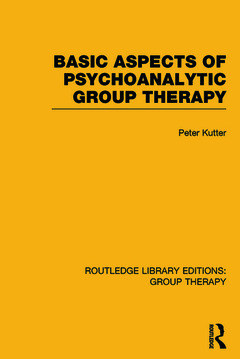Basic Aspects of Psychoanalytic Group Therapy Routledge Library Editions: Group Therapy Series
Auteur : Kutter Peter

First published in English in 1982 and based on more than five years of experience with therapy groups in the author?s own practice, this book aims to introduce the reader to psychoanalytic group therapy. Assuming little previous knowledge, it presents the subject in a progressive and illustrative way, and gives a central place to case material that was otherwise rarely published. Theory remains in the background and serves only to direct light on to problems which arise in practice, such as working through the early mother child relationship and the Oedipus complex in the group situation, the theory of the group process, and the various forms of transference, including the group conductor?s counter-transference.
The book?s special value consists in its practical non-dogmatic orientation, in its integration of a variety of conceptions about groups, in its vividly illustrative case presentations, and in the open discussion of the problem of counter-transference. Written in non-technical language, it gives a lively picture of how ?the business of psychoanalytic group therapy? is managed, and will be of value to group analysts in practice and in training, as well as those interested in a more general way in psychoanalytic group therapy and what it is all about.
Preface to the English Edition. Preface to the German Edition. 1. Indication for Treatment and the Contract 2. Understanding, Observing, Interpreting 3. Three Theoretical Models of Psychoanalytic Group Therapy 4. The First Session of Group 1 5. Hatred and Love Between the Sexes: Continuation of the Process in Group 1 6. Resistance and Defence in Psychoanalytic Group Therapy 7.Transference in Psychoanalytic Group Therapy, Exemplified by Group 2 8. The Struggle with Authority. Subsequent Course of the Group Process in Group 2 9. The Group Process: Each Individual Participates in Shared Events 10. Early Mother-Child Relationship in the Group: Split into Good and Bad 11.Self-Destruction of a Group or the Result of Constructive Separations? 12. Sexuality and the Oedipus Complex in the Group 13. Aggressiveness in the Group 14. The Conductor’s Function 15. The Relationship Between Individuals, the Psychoanalyst and the Group 16. The End Phase of the Group Process 17. After Group Therapy has Ended. Notes. Index.
Date de parution : 08-2014
15.6x23.4 cm
Date de parution : 11-2016
15.6x23.4 cm
Thème de Basic Aspects of Psychoanalytic Group Therapy :
Mots-clés :
Young Man; gage; Psychoanalytic Group Therapy; narcis; Girl Friend; sistic; Vice Versa; personality; Mr Gage; disorders; Identity Disorder; process; Borderline Personality Organization; end; Early Mother Child Relationship; phase; Idealized Parent Imago; borderline; Classical Neuroses; organization; Conductor's Interpretations; Narcissistic Personality Disorders; Fiftieth Session; Positive Oedipal Configuration; Group's Potency; Reliable Father Figure; Wolfgang Loch; Constructive Phase; Deep Unconscious Layer; Negative Oedipus Complex; Oral Sadistic Stages; Psycho Sexual Development Stages; Desirable Therapeutic Effect; Men's Actual Behaviour; Group Member's Position



